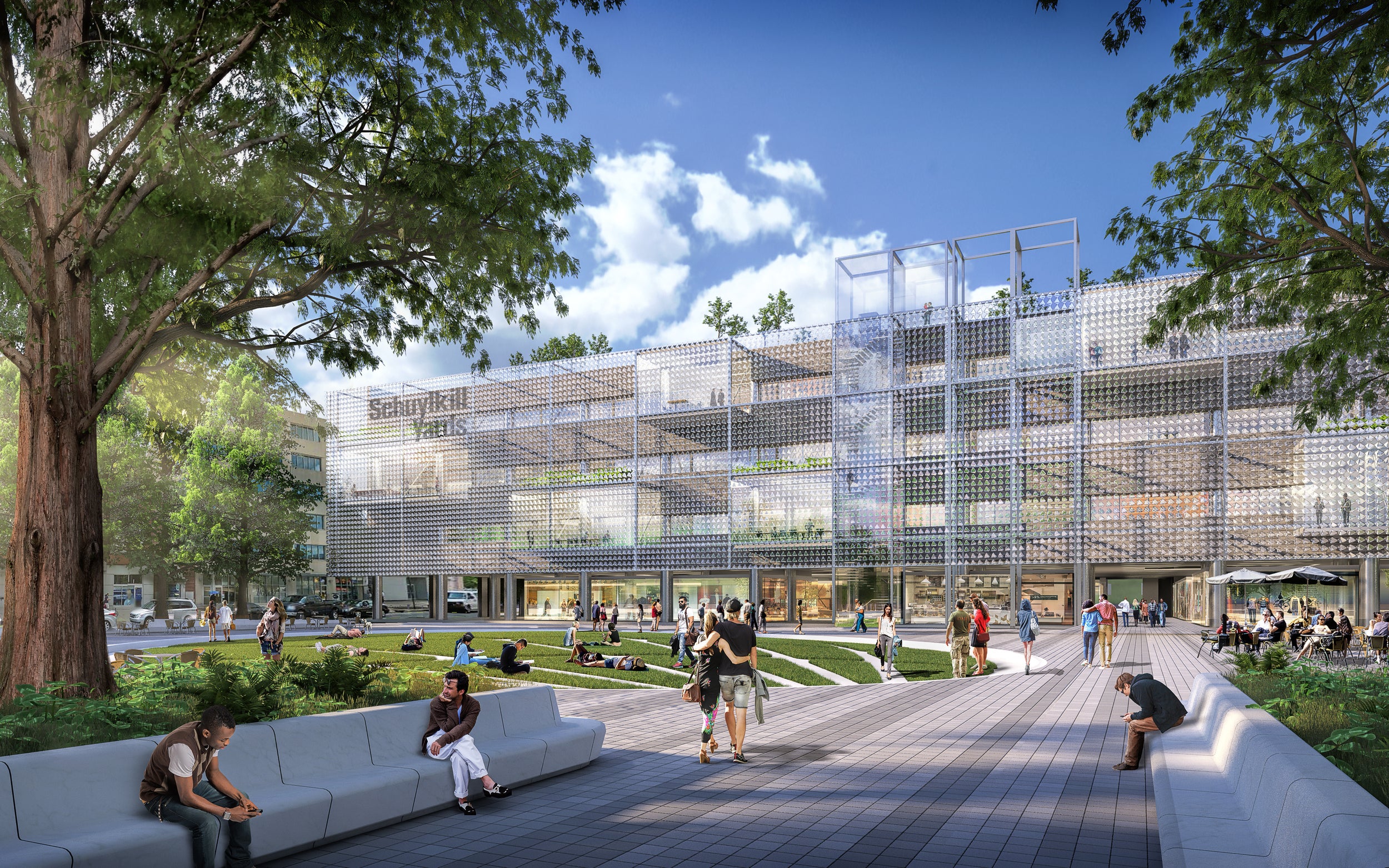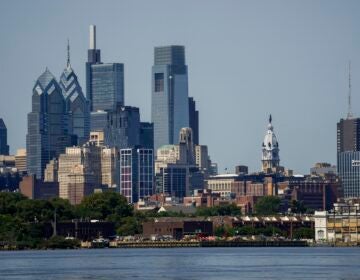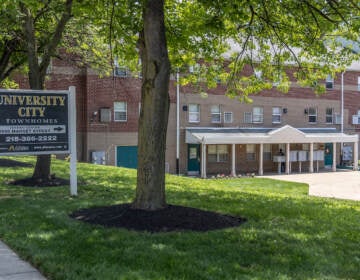Planning Commission hears community concerns, supports rezoning for first phase of Schuylkill Yards

Jerry Sweeney breezed through a presentation he’s given dozens of times before: Brandywine Realty Trust’s vision for a new 14-acre, $3.5 billion “innovation district” just west of 30th Street Station: Schuylkill Yards. Sweeney, Brandywine’s CEO, paused only to take breaths as he highlighted the project’s first phase: Converting a barren plaza into a lively park, modernizing the facade of a mid-century landmark, and upgrading a pair of surface parking lots into gleaming glass towers.
Sweeney trudged down to 1515 Arch Street to gather the Planning Commission’s support for a pair of zoning bills needed to advance the first phase of Schuylkill Yards, support he ultimately won. With the Planning Commission’s backing, the bills will return to City Council for final passage.
But Council may not rush to pass the bills, at least not until a few lingering questions are answered by Brandywine and its partner on the project, Drexel University. Representatives from neighboring communities testified to their general support for Schuylkill Yards, but expressed continued concerns over the project’s potential for gentrification, displacement, and jobs – concerns echoed by Planning Commission members.
Following Sweeney’s prepared remarks, which focused entirely on the project’s plans for green spaces and high-end architecture, Commissioner Maria Gonzalez, president of HACE, first asked if an affordable housing was planned for Schuylkill Yards. “We’re not contemplating at the current time affordable housing per se as part of the Schuylkill Yards development,” said Sweeney.
Gonzalez followed up by asking about setting aside some units for affordable housing. “We’re involved in a number of discussions right now with the community at how we can best address that collaboratively,” Sweeney replied. Market-rate apartments should work to satisfy a lot of the housing demand from the young professionals expected to fill Schuylkill Yards’ labs and offices but spillover demand into neighborhoods like Powelton Village and Mantua have those communities concerned.
“Where people can’t afford to live in the Schuylkill Yards development, Mantua, just two blocks away, becomes ideal,” said Michael Thorpe, executive director of Mt. Vernon Manor, a community development corporation in Mantua. According to Thorpe, developers have already begun purchasing vacant lots and abandoned buildings with an eye towards apartments for young professionals and more housing for Drexel students. While the community welcomes the infill development, residents there today worry about being driven out by rising real estate prices or student demand.
An equitable mix of market-rate development, affordable housing, and student housing is needed, said Donna Cooper, a community engagement consultant working in Mantua. Too much student housing “creates a very transitional population,” she said.
Mantua residents want to see the neighborhood rezoned to mostly single-family housing, said Thorpe, as a way of managing neighborhood growth.
Drexel’s student population has grown faster than the number of dorm beds in recent years, driving undergraduates into the neighborhoods just north of campus. Commissioner Cheryl Gaston, a real estate attorney, asked Sweeney if the development would feature any student housing to lessen the scholarly sprawl into Powelton and Mantua. Not specifically, said Sweeney, adding that some grad students may move into the proposed market-rate apartments.
Representatives from neighborhood groups in Powelton and Mantua expressed their support for the rezoning bills, but noted their lingering concerns with the development. “We’re very excited about this development… but we’re aware that it’ll have significant impacts on the surrounding communities,” said John Phillips, president of the Powelton Village Civic Association. “It is such a unique and comprehensive proposal going forward that we feel that it should not be enacted as law until there is a very strong community benefits agreement directly with the impacted neighborhoods.”
Sweeney said he was “confident” such an agreement would be in place before City Council took up the bill again, but cautioned, “We need to make sure that we understand that a development, as grand as Schuylkill Yards is, can’t solve every single problem in every single neighborhood in the City of Philadelphia.”
Phillips wanted to see job training in the neighborhood and local hiring incorporated into the construction work going forward. Sweeney said the development aimed to create 15,000 permanent jobs, plus thousands more in construction work.
Sweeney said Brandywine is already working with Drexel and University City District’s West Philadelphia Skills Initiative “to identify businesses that we are in the process of introducing to Brandywine’s broad tenant base in the city,” said Sweeney. The idea is to support local companies by helping them solicit business from Brandywine’s existing tenants and those it hopes to attract to Schuylkill Yards. On top of technical guidance and introductions, Sweeney said Brandywine was putting real money behind the effort. “We’ve agreed to underwrite ten percent of the contract cost of that first year contract of the vendors that are selected by our tenants,” he said.
Sweeney also said that the company had launched an apprenticeship program with local building trades unions, which recently started its first class of 40 community residents. Sweeney also touted a Brandywine-led financing program “that will provide hundreds of thousands of dollars to start up companies who are located in these targeted zip codes, primarily to help them get into the procurement channels.”
Despite the goodwill gestures and job programs, the surrounding communities remained concerned. “Unfortunately as present, we have not seen a willingness from Drexel or Brandywine to provide mitigation for this project in a way that we believe is appropriate, but we are looking forward to working with all parties to resolve this in the future,” said Phillips. Still, all parties said they expected to reach an accord in the coming weeks.
The two ordinances would rezone the parking lot on JFK Boulevard from 30th to 32nd Streets from industrial to CMX-5, the most permissive zoning designation in terms of density and scale, and extend an overlay district aimed at encouraging transit-oriented development. Both passed unanimously, with Commissioners Nancy Rogo Trainer and Joe Syrnick recusing themselves and Commissioner Gaston abstaining on the overlay district extension.
Brandywine hopes to kick off construction at Schuylkill Yards this spring, assuming City Council passes the zoning ordinances, starting with Drexel Green, which will replace a lifeless plaza between 30th Street Station and One Drexel Plaza on the southwest corner of 30th Street and JFK Boulevard. Sweeney described the park as integral to the innovation district’s vision, a central green for felicitous meetings among the bright minds Brandywine hopes to attract there. But it’s also a gesture of goodwill to the community, promising to build the community space first.
Work on the old Bulletin building would follow soon after, said Sweeney. Brandywine is still working with its architects on the final designs for One Drexel Plaza, but generally proposes a new scrim facade recalling the work of International Style architect George Howe. Most famous for designing the PSFS Building, Howe’s final commission before his death in 1955 was for the exterior of One Drexel Plaza, then home to the Philadelphia Evening Bulletin.
Sweeney also offered a few new details on Schuylkill Yards’ new buildings. Brandywine proposes a pair of new towers where a surface parking lot is today across JFK Boulevard from the plaza. The first tower would be 783,000 square foot mixed-use office tower located at the corner of JFK and 30th Street, with 15,000 square feet of retail on the lower floors, 561,000 square feet of office space, and 130,000 square feet for laboratories. A second, exclusively residential 383,000 square-foot tower would replace the rest of the surface lot.
WHYY is your source for fact-based, in-depth journalism and information. As a nonprofit organization, we rely on financial support from readers like you. Please give today.






